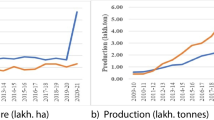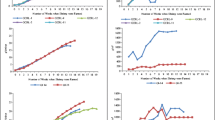Abstract
This study analyzed the financial viability of inserting the biofloc technology (BFT) system and maintaining the conventional culture system for the marine shrimp Litopenaeus vannamei in a farm located in the state of Pernambuco, northeastern Brazil. To obtain information related to investment and operating costs, we used three ponds (625 m2 each) covered with high-density polyethylene operating with the BFT system and data from three conventional ponds (2.86 ha each) used in a farm during 2014. The total production costs of BFT were eight times higher than the conventional system. Operating profit and profitability index were US$ 51,871.54 ha−1 year−1 and 30.22 % for BFT, and US$ 21,523.83 ha−1 year−1 and 59.79 % for the conventional system, respectively. In investment analysis, indicators were favorable for both systems, with greater expressiveness of the net present value (NPV) for the BFT (US$ 142,004.42) and internal rate of return (IRR) 4.5 times higher for conventional system (131.86 %). To achieve favorable results of profitability and viability, combined with the ability to contribute to the sustainable development of marine shrimp farming, the BFT system is a promising alternative to replace traditional systems used in northeastern Brazil.


Similar content being viewed by others
Notes
Reference value (November/2014—US$ 1.00 = R$ 2.49).
References
Abreu MCS, Mattos P, Lima PES et al (2011) Shrimp farming in coastal Brazil: reasons for market failure and sustainability challenges. Ocean Coast Manag 54:658–667
Avnimelech Y (1999) C/N ratio as a control element in aquaculture systems. Aquaculture 176:227–235
Avnimelech Y (2012) Biofloc technology—a practical guide book. World Aquaculture Society, Louisiana
Brandão ASP, Rezende GC, Marques RWC (2006) Crescimento agrícola no período 1999/2004: a explosão da soja e da pecuária bovina e seu impacto sobre o meio ambiente. Econ Aplic 10(2):249–266
Buarque C (1984) Avaliação econômica de projetos: uma apresentação didática. Elsevier, Rio de Janeiro
Burford MA, Thompson PJ, Mcintosh RP et al (2003) Nutrient and microbial dynamics in high intensity, zero-exchange shrimp ponds in Belize. Aquaculture 219:393–411
Campos KC, Campos RT (2006) Alternativa econômica para o novo rural no Nordeste brasileiro: o cultivo do camarão Litopenaeus vannamei em água doce. GEPEC 10(2):40–53
Cavalcanti LE (2012) Aspectos geoambientais da carcinicultura no Rio Grande do Norte e seus desdobramentos legais: a implementação da licença ambiental em defesa do meio ambiente. REDUNB 10:71–88
Coelho MAS (2005) Análise de custo/volume/lucro e investimentos em carcinicultura de pequeno porte. Custos e Agronegócio 1(1):62–68
De Schryver P, Crab R, Defoirdt T et al (2008) The basics of bio-flocs technology: the added value for aquaculture. Aquaculture 277:125–137
Ebeling JM, Timmons MB, Bisogni JJ (2006) Engineering analysis of the stoichiometry of photoautotrophic, autotrophic, and heterotrophic control of ammonia-nitrogen in aquaculture production systems. Aquaculture 257:346–358
Guy JA, Johnston B, Cacho OJ (2009) Economic assessment of an intraspecific cross of silver perch (Bidyanus bidyanus Mitchell) for commercial farming. Aquac Econ Manage 13(4):328–343
Ha TTT, Dijk HV, Bush SR (2012) Mangrove conservation or shrimp farmer’s livelihood? The devolution of forest management and benefit sharing in the Mekong Delta, Vietnam. Ocean Coast Manag 69:185–193
Hanson T, Samocha T, Morris T et al (2013) Economic analyses project rising returns for intensive biofloc shrimp systems. Global Aquac Advocate 16:24–26
Hargreaves JA (2013) Biofloc production systems for aquaculture. Southern Regional Aquaculture Center—SRAC, EUA
Hossain S, Alam SMN, Lin CK et al (2004) Integrated management approach for shrimp culture development in the coastal environment of Bangladesh. World Aquac 35:35–67
Jory DE, Cabrera TR, Dugger DM et al (2001) A global review of shrimp feed management: status and perspectives. In: Browdy CL, Jory DE (eds) The new wave, proceedings of the special session on sustainable shrimp culture. Aquaculture, Baton Rouge
Kam LE, Leung P (2008) Financial risk analysis in aquaculture. In: Bondad-Reantaso MG (ed) Understanding and applying risk analysis in aquaculture. Italy, Rome
Krummenauer D, Peixoto S, Cavalli RO et al (2011) Superintensive culture of white shrimp, Litopenaeus vannamei, in a biofloc technology system in Southern Brazil at different stocking densities. J World Aquac Soc 42:726–733
Martin NB, Serra R, Oliveira MDM et al (1998) Sistema Integrado de Custos Agropecuários-CUSTAGRI. Inf Econ 28(1):7–28
Matsunaga M, Bemelmans PF, Toledo PEN (1976) Metodologia de custo utilizada pelo IEA. Agricultura em São Paulo 23(1):123–139
Moss SM (2002) Dietary importance of microbes and detritus in Penaeid shrimp aquaculture. In: Lee CS, O’Bryen P (eds) Microbial approaches to aquatic nutrition within environmentally sound aquaculture production systems. World Aquaculture Society, Baton Rouge
MPA Ministério da Pesca e Aquicultura (2012) Boletim Estatístico da Pesca e Aquicultura: Brasil 2010. http://www.mpa.gov.br. Cited 18 Oct 2014
Natori MM, Sussel FR, Santos ECB et al (2011) Desenvolvimento da Carcinicultura Marinha no Brasil e no Mundo: avanços Tecnológicos e Desafios. Inf Econ 41(2):61–73
Noronha JF (1981) Projetos agropecuários: administração financeira, orçamentação e avaliação econômica. Fundação Estudos Agrários Luiz de Queiroz, São Paulo
Pinheiro WC, Filho JA, Maracajá PB (2007) Efeitos climáticos e físico–químicos sobre a biologia do Litopenaeus vannamei cultivado em viveiro. Rev Verde 2(2):142–150
Rocha IP, Rodrigues J (2004) A carcinicultura brasileira em 2003. Rev Associação Brasileira de Criadores de Camarão 6:30–36
Rocha IP, Rodrigues JF, Borba MG et al (2013) Levantamento da infraestrutura produtiva e dos aspectos tecnológicos, econômicos, sociais e ambientais da carcinicultura marinha no Brasil em 2011. ABCC, Natal
Sanches EG, Silva FC, Ramos APFDA (2014) Viabilidade econômica do cultivo do robalo-flecha em empreendimentos de carcinicultura no nordeste do Brasil. Boletim do Instituto de Pesca 40(4):577–588
Shang YC, Leung P, Ling BH (1998) Comparative economics of shrimp farming in Asia. Aquaculture 164:183–200
Silva SLG, Pontes FST, Pontes FM et al (2012) Análise de investimento na carcinicultura do Rio Grande do Norte: um estudo de caso. Rev Caatinga 25(1):168–175
Valiela I, Bowen JL, York JK (2001) Mangrove forests: one of the World’s threatened major tropical environments. Bioscience 51(10):807–815
Varian H (2006) Microeconomia: princípios básicos. Elsevier, Rio de Janeiro
Wainberg AA, Ribeiro FAZ, Ribeiro K et al (2011) Aquaculture in Rio Grande do Norte, NE-Brazil: past, present and future. J World Aquac 42(1):21–25
Wasielesky W Jr, Atwood H, Stokes A et al (2006) Effect of natural production in a zero exchange suspended microbial floc based super-intensive culture system for white shrimp Litopenaeus vannamei. Aquaculture 258:396–403
Acknowledgments
The authors would like to acknowledge the Conselho Nacional de Desenvolvimento Científico e Tecnológico (CNPq) for the financial support.
Author information
Authors and Affiliations
Corresponding author
Rights and permissions
About this article
Cite this article
Rego, M.A.S., Sabbag, O.J., Soares, R. et al. Financial viability of inserting the biofloc technology in a marine shrimp Litopenaeus vannamei farm: a case study in the state of Pernambuco, Brazil. Aquacult Int 25, 473–483 (2017). https://doi.org/10.1007/s10499-016-0044-7
Received:
Accepted:
Published:
Issue Date:
DOI: https://doi.org/10.1007/s10499-016-0044-7




